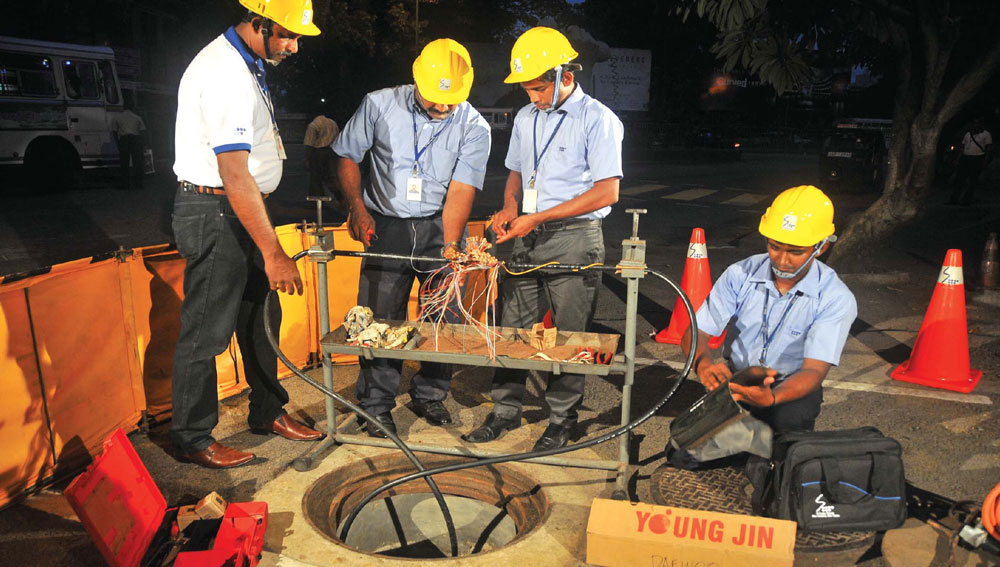SRI LANKA TELECOM

Q: How has SLT provided leadership in the development of technology – for the realisation of a more connected Sri Lanka?
A: With a history spanning over 160 years, SLT has been evolving since its inception.
From Strowger switches and analog technology, to digital exchanges and satellite communications, the company has introduced new technology to the country throughout its existence.
The group’s transformation and technology deployments over the years have been undertaken with the aim of serving Sri Lanka, and providing reliable connectivity platforms for its citizens. This has involved transforming our legacy network into a new generation network and developing broadband capabilities with the understanding that high penetration could positively impact GDP growth.
SLT also launched ‘i-Sri Lanka,’ a landmark islandwide network modernisation project to upgrade the existing copper network with fibreoptics. We have used LTE technology in over 1,500 base stations to provide wireless connectivity and reliable broadband capabilities. Through this, the company had an impact on the direction of the country and its economic development.
The national backbone network’s (NBN) connectivity has been strengthened further through the fibreoptic network, which covers the entire island to facilitate the connection of any enterprise and state institution.
Supporting this is our international connectivity. This includes the South East Asia-Middle East-Western Europe (SEA-ME-WE) fibreoptic submarine communications cable systems; SMW3, SMW4 and SMW5 provide reliability for customers, which will be cemented with the upcoming SMW6.
The Dhiraagu-SLT and Bharatha Lanka cables connecting the Maldives and India also support SLT’s ability to serve as a hub for data transmission in Southeast Asia.
To achieve SLT’s vision of a connected Sri Lanka, accelerated programmes will be launched to ensure that at least 40 percent of households possess fibreoptic connections by 2022. Furthermore, government institutions, enterprises, industrial zones, apartment complexes, hospitals, schools and other important locations will also be connected.

Q: Could the adoption of new technologies help attract investments to Sri Lanka?
A: The IT industry is among the fastest growing in the country, earning almost US$ 1 billion last year. Many foreign companies look to engage our IT professionals and have invested in software development.
This is what SLT looks to achieve as part of its digital transformation. As such, it is looking to build an ecosystem with local and foreign partners to develop a digital culture, software applications, IoT platforms and data analytics among others. With these developments, we can attract investments in the IT industry – especially in business process outsourcing (BPO) and business process management (BPM).
Q: Has SLT planned any major investments for the country’s IT development?
A: The company’s drive to expand its fibreoptic network is a major investment.
We will also be collaborating with leading partners in the region to introduce new application software platforms to promote a DevOps culture so that Sri Lankans can develop their capabilities and join attractive industries such as the IT industry. In the future, we want to establish intelligent
and automated government systems and processes, which is why 850 state institutions are connected to the Lanka Government Network 2.0 (LGN 2.0). Our aim is to expand this to 3,500 institutions.
Q: Compared to other Asian countries, what areas must Sri Lanka focus on developing?
A: In my opinion, knowledge must be developed. We have experts in niche markets who could be used to promote Sri Lanka as a testing hub. Furthermore, many knowledgeable people are in the country so we must improve our expertise in IT and Sri Lanka’s standing as a knowledge hub.
To support the development of IT professionals, SLT established the Sri Lanka Technological Campus (SLTC). Our aim is to develop an ecosystem to ensure that the country becomes a hub for research and product testing.
Q: How does SLT address the customer experience?
A: All this technology and transformation is meaningless without a good customer experience. This is why customer service is viewed across network verticals to provide an end-to-end service. In line with this, our network operations centres are being converted into service operations centres.
Contact centres and every customer touch point will use a single platform to provide insights on services offered previously; and if any customer has a complaint, the service operations centre will become involved immediately. This team will analyse the problem to identify the cause and ensure that when it is resolved, it’ll be resolved for virtually everyone.
A number of indicators will be used to calculate a customer experience index. This is how SLT is transforming its culture from one of network operations to service operations. In our view, this is the key to digital transformation.

Priyantha Fernandez
Chief Operating Officer
Chief Technology Officer
Telephone 2021000
Email pr@slt.lk
Website www.slt.lk




